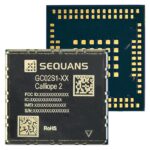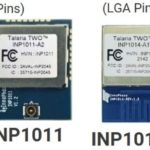The auctioning of the C-band for 5G use has raised concerns in North America that signals could interfere with aircraft altimeter operations. 5GTW asked a filter engineer and a test expert if there’s a problem and how to fix it.
5G
5G transceiver doubles Tx/Rx channels and bandwidth
The ADRV9040 SoC from Analog Devices provides 400 MHz channel bandwidth across eight transmit and receive channels
Cellular LTE Cat 1 module supports 4G and 5G
The Calliope 2 GC02S1 module from Sequans lets you take advantage of wide coverages for IoT devices with data rates to 10 Mb/sec. Sequans Communications series of Cat 1 IoT modules based on its second generation, LTE Cat 1bis chip, Calliope 2, are now available. The Calliope 2 GC02S1 low-cost, low-power, IoT-optimized modules that support…
GaN transistors power telecom equipment and phone chargers
STMicroelectronics adds to it’s STPOWER portfolio with 15 A, 650 V power devices.
5G signals push a need for new materials
5G’s RF signals and data rates bring development of new liquid crystal polymer materials for connectors, and PCBs to minimize signal losses
SoC for offers eight TX and RX channels of 400 MHz for 5G radio development
Analog Devices, Inc. announced a breakthrough RadioVerse System-on-Chip (SoC) series providing radio unit (RU) developers with an agile and cost-effective platform to create the most energy-efficient 5G RUs in the industry. The new SoC series provides advanced RF signal processing with expanded digital functionality and RF capacity that greatly improves 5G RU performance and energy […]
LTE chip gets iSIM security certification
The Monarch 2 LTE chip from Sequans includes iSIM that’s now “IoT Safe” per GSMA. Sequans Communications announced that the industry’s first GSMA-compliant integrated SIM (iUICC) is now Common Criteria certified and available on its Monarch 2 LTE-M/NB-IoT chip. With iSIM, the SIM is integrated directly into the chip. That, according to Sequans, makes it…
BLER: A critical parameter in cellular receiver performance
5G user equipment receiver performance is critical for high-quality connectivity and maximum data throughput. Block-error rate provides an effective metric in demodulation and determining receiver sensitivity.
IoT wireless modules shrink in size
Innophase Wi-Fi/Bluetooth modules get 40% size reduction.
Flexible printed circuit antennas handle LTE, 4G and 5G NR transmissions
Antenova Ltd is announcing ‘Affini’, part number SRFL064, which is a flexible printed circuit (FPC) antenna for the LTE, 4G, and 5G NR networks in global markets. This antenna covers all main 4G bands plus 617-698MHz which offers 5G coverage and the popular Band 71. The Affini antenna measures 78mm x 17mm x 0.15mm, which […]











